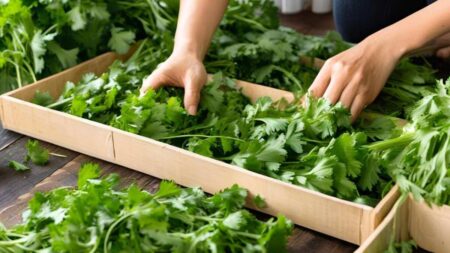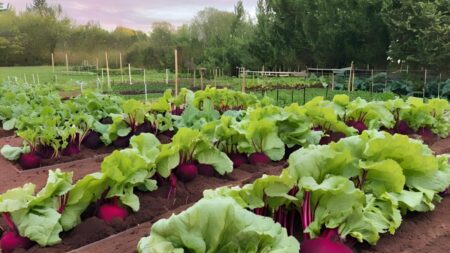Leafy greens are a staple in many gardens, offering a fresh and nutritious addition to meals. Whether you’re an eco-conscious individual, a beginner gardener, or a seasoned permaculture practitioner, knowing the best way to harvest leafy greens is essential for maintaining a productive and sustainable garden. This guide will provide you with everything you need to know about harvesting leafy greens effectively and ensuring a bountiful harvest season after season.
1. Introduction
Harvesting leafy greens is more than just cutting leaves; it’s an art that requires timing, technique, and care. Not only does proper harvesting ensure you get the most out of your garden, but it also helps plants continue to grow and produce. In this guide, we will explore the best way to harvest leafy greens, focusing on eco-friendly practices that benefit both your garden and the environment.
2. Understanding When to Harvest Leafy Greens
The timing of your harvest is crucial for getting the best flavor and nutritional value from your greens. Leafy greens like lettuce, spinach, kale, and arugula can be harvested at different stages of their growth, depending on the desired taste and texture.
- Baby Greens: These are harvested early, usually within 25-30 days of planting. They are tender and mild in flavor, perfect for salads.
- Mature Greens: These are harvested when the plant has reached full size, typically between 40-60 days, depending on the variety. Mature greens have a more robust flavor and are great for cooking.
To determine the best time to harvest, look for leaves that are crisp, vibrant in color, and free from yellowing or wilting. Harvest in the morning when the leaves are most hydrated and flavorful.
3. Best Techniques for Harvesting Different Types of Leafy Greens
Different leafy greens require different harvesting techniques to ensure the plant remains productive. Here are the best methods for some of the most popular varieties:
- Lettuce: For loose-leaf varieties, you can use the “cut and come again” method, where you snip off the outer leaves about an inch above the base, allowing the plant to regrow. For head lettuce, wait until the head is fully formed and cut at the base.
- Spinach: Pinch or cut the outer leaves when they are large enough to eat, allowing the inner leaves to continue growing. This encourages the plant to produce more leaves over time.
- Kale: Harvest kale leaves from the bottom up. Cut the larger, lower leaves close to the stem, leaving the smaller, upper leaves to continue growing.
- Arugula: Arugula can be harvested leaf by leaf or by cutting the entire plant an inch above the soil. For a continuous harvest, take only a few leaves from each plant.
- Swiss Chard: Harvest outer leaves by cutting them close to the base of the plant. This method will encourage new growth from the center of the plant.
By using these techniques, you can extend the life of your plants and enjoy fresh greens throughout the growing season.
4. Tools Needed for Harvesting
Having the right tools makes harvesting easier and more efficient. Here are some essentials:
- Sharp Scissors or Garden Shears: These are perfect for snipping leaves without damaging the plant.
- Harvesting Knife: A small, serrated knife works well for cutting through thicker stems.
- Harvesting Basket or Colander: Use these to collect your greens. A basket allows for airflow, preventing the greens from wilting quickly.
Make sure all tools are clean and sharp to prevent disease and ensure clean cuts.
5. Post-Harvest Care for Leafy Greens
Once harvested, proper care is crucial to maintain the freshness and quality of your leafy greens. Follow these steps:
- Rinse Immediately: Wash your greens in cold water to remove any dirt or pests.
- Dry Thoroughly: Use a salad spinner or gently pat the leaves dry with a clean towel. Removing excess moisture helps prevent spoilage.
- Storage: Store your greens in the refrigerator in a breathable bag or container. This keeps them crisp and fresh for up to a week.
6. Common Mistakes to Avoid
To get the most out of your leafy greens, avoid these common harvesting mistakes:
- Overharvesting: Taking too many leaves at once can weaken the plant and reduce future yields.
- Harvesting Too Late: Waiting too long can result in bitter leaves and tough textures.
- Improper Cutting: Rough handling or tearing can damage the plant, making it susceptible to disease.
7. Encouraging Sustainable Gardening Practices
As gardeners, it’s important to adopt practices that promote sustainability and environmental health. Here are a few tips:
- Use Organic Fertilizers: Organic fertilizers improve soil health and promote plant growth without harmful chemicals.
- Practice Crop Rotation: Rotate your leafy greens with other crops to prevent soil depletion and reduce pest problems.
- Compost Plant Waste: Composting plant waste returns nutrients to the soil and reduces waste.
8. Conclusion
Harvesting leafy greens is a rewarding experience that provides fresh, nutritious food for you and your family. By following the best practices outlined in this guide, you can enjoy a continuous supply of greens while promoting healthy and sustainable gardening habits. So grab your shears, head out to the garden, and start harvesting!
Taking the time to harvest your greens properly ensures a healthy garden and a healthy diet. Encourage your friends and family to join you in growing and harvesting their own leafy greens — it’s a great way to connect with nature and enjoy the fruits (and veggies) of your labor.
By following these steps, you’ll not only maximize your harvest but also contribute to a healthier environment and lifestyle. Happy gardening!
This blog post should attract readers from all backgrounds, encouraging them to take action in their gardens while providing a thorough understanding of the best ways to harvest leafy greens.









20 Comments
Not only does proper harvesting ensure you get the most out of your garden, but it also helps plants continue to grow and produce. I like this post.
Loved the DIY composting tips!
I’ve been thinking about starting my own compost bin, and your guide gave me the push I needed. Can you do a post on vermicomposting next?
“I can’t believe how much I’ve learned from your blog. The articles on sustainable gardening practices are particularly useful. It’s wonderful to find a site that emphasizes eco-friendly techniques.”
“This website is my go-to resource for all things related to home gardening. The content is always fresh, informative, and very well-written. Thank you for sharing such valuable insights!”
“Home Garden Live Advice Inc. appears to be an engaging website for gardeners of all skill levels. The name suggests a variety of live advice and tips, which could be incredibly valuable for anyone looking to enhance their gardening knowledge. Can’t wait to dive in!”
I’m blown away by your garden’s beauty! Your advice on seasonal planting is exactly what I needed to get my garden thriving. Looking forward to more of your expert tips.
Great Resource! – “I love how informative your articles are! They provide detailed advice that has truly helped improve my gardening skills. Keep up the great work!
I love how detailed your guides are! The step-by-step instructions make it so easy for beginners like me to follow. Looking forward to more posts like this!
This site has transformed the way I approach home gardening. It’s inspiring and incredibly informative!
I appreciate the seasonal planting calendar!
I’m new to gardening and this calendar will help me plan my planting better. Do you have a version for indoor plants as well?
Your DIY home improvement ideas are fantastic! I’m always looking for budget-friendly ways to refresh my space, and your tips are so creative and easy to implement.
Your soil preparation guide was spot on!
I never realized how important pH balance is for my plants. I’m going to test my soil this weekend. Thanks for the tips!
“I appreciate the focus on eco-friendly practices! It’s great to see sustainable gardening promoted.”
“I love that this website provides advice for both small and large garden spaces. Perfect for urban gardeners like me.”
“A garden is like a living canvas where you can express your creativity and enjoy the rewards of your efforts. From the vibrant colors of blooming flowers to the satisfaction of harvesting your own vegetables, gardening enriches your life with both beauty and nourishment.”
I never realized how much of an impact a well-organized garden can have on the overall look of my home. Your landscaping tips have inspired me to finally start my own garden project!
This website is a goldmine for anyone looking to improve their gardening skills! So many practical tips and ideas.
Pingback: Best Time to Harvest: Maximize Your Crop’s Full Potential
Pingback: Top Vegetables with Powerful Anti-Inflammatory Benefits
Pingback: Top Benefits of Leafy Greens: Boost Your Strength and Wellness